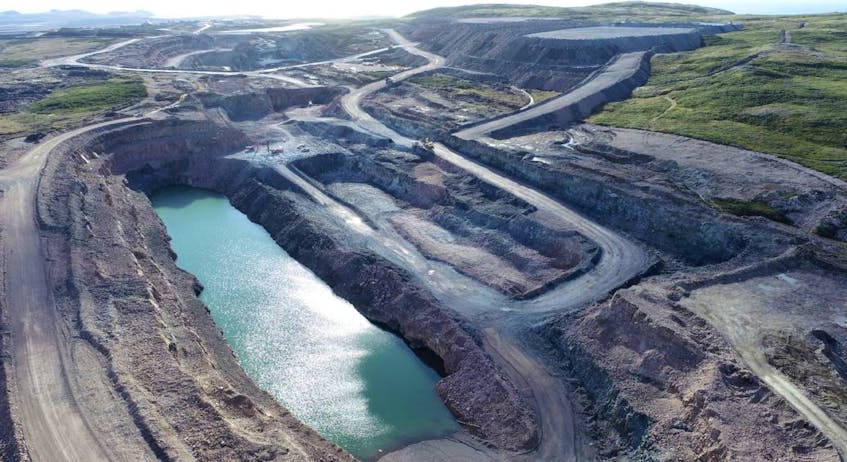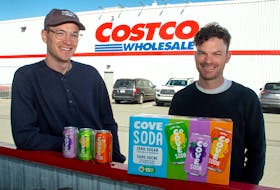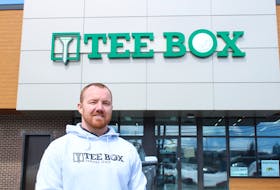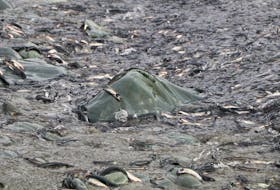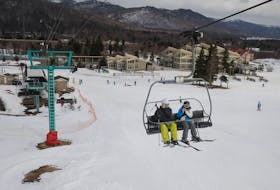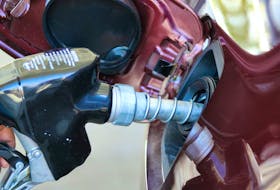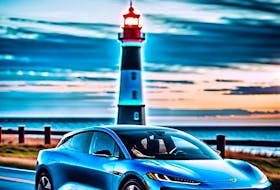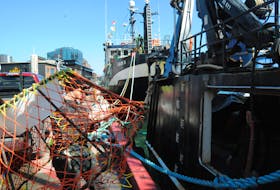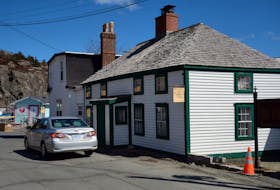When Paul Pike was a teenager, he and some of his friends earned their summer wages loading fluorspar onto ships in St. Lawrence harbour.
It was the 1970s and the fluorspar deposits, being mined by Alcan at that time, meant jobs for many local people.
But when the mine shut down in the late 1970s, the ships stopped coming to St. Lawrence.
This year, 40 years after the last load of fluorspar left St. Lawrence harbour, the ships are coming back. By December, they’ll be sailing into this Burin Peninsula town to load up with fluorspar to take to markets in the United States.
These ships will be much larger than the ones Pike helped load up when he was a teenager. In fact, they won’t be able to dock in the harbour in St. Lawrence, Instead, they’ll be tying up at a brand-new terminal at Blue Beach, just up the shore.
The $10 million facility is a project of Canada Fluorspar (NL) Ltd., as part of its overall mine operation. Construction of this facility began in May and the contractor, RGI, is about finished.

Bill Dobbs, CEO of CFI, told SaltWire completion of that terminal will mean the company will no longer have to send truckloads of fluorspar over the highway to Marystown to the Kiewit facility.
They've been doing that since August of 2018, when they made their first shipment after getting the mine back up and running.
The terminal at Blue Beach will solve a lot of challenges for the operation, he said.
“At our new (terminal), we will be able to bring in larger ships. If we have a customer in a far-away part of the world, sending small loads is not cost-effective. If we can send 20,000 tonnes, for instance, as a partial cargo on a ship that may be holding tonnes of other stuff, it’s a lot better for us. It will let us reach more markets."
“We won't have to truck our product 55 kilometres over the highway to Kiewit. It’s very costly to do that. So this saves us money, and it also reduces emissions from trucking.”
In addition, he said, the Kiewit facility limits the length of the ships that can dock there. There, the company is restricted to ships that carry a maximum load of 12,000 tonnes.
The terminal will help the company reach new markets.
At our new facility, we will be able to bring in larger ships,” said Dobbs. “If we have a customer in a far-away part of the world, sending small loads is not cost-effective.
“If we can send 20,000 tonnes, for instance, as a partial cargo on a ship that may be holding tonnes of other stuff, then it’s a lot better for us. It will let us reach more markets that, right now, cost us so much in shipping that it would make the cost of our product too high.”
Dobbs said they expect about 18-25 shiploads of fluorspar to leave the Blue Beach terminal annually.

Faith in the future
The completion of the terminal also gives the people of St. Lawrence a little more faith in the future of the mining operation said Pike, who is now the mayor of St. Lawrence.
The town has seen the mine shut down many times since it began over 100 years ago.
Pike said the completion of the terminal by CFI reassures them the company will be here for the long haul.
“That says to us that they are serious about this mine, they want to develop this mine and they’re going to be here for longer than we had first anticipated."
The town had always hoped fluorspar would, once again, be shipped directly from there. In fact, the terminal was originally part of the proposal when CFI came to town to get the mine back in operation.
“That says to us that they are serious about this mine, they want to develop this mine and they’re going to be here for longer than we had first anticipated."
However, according to the mayor, there was some concern the terminal might not happen because the cost of getting the actual mine back in operation was higher than first anticipated. The company had to postpone the terminal build.
That was troubling for the town, said Pike.
“We didn’t want the material taken and shipped from anywhere but here because we felt it would have an impact on the number of jobs associated with the mine.”

Pike says the terminal should create a few more jobs for the local area.
The mine operation has also added to the town’s tax base over the past few years, added the Mayor.
“They started paying taxes even before the mine went into production,” he noted.
“And they do help the town... and local organizations in a lot of ways,” said Pike. “They are good corporate citizens.”
It’s also meant jobs for people from the Burin Peninsula region.
“That glass on your iPhone or your laptop computer screen, it contains fluorspar. It’s in lithium batteries, refrigerators, air conditioning units."
According to Dobbs, the company has 280 people on the payroll right now — miners, processing plant operators and administrative staff. He said 98 per cent of them are from Newfoundland and Labrador and 80 per cent of those are from the Burin Peninsula.
On the matter of longevity, Dobbs said there are enough high-quality fluorspar deposits at St. Lawrence to supply world markets for decades.
Because of the multiple uses for fluorspar, demand for the mineral should remain steady as well.
Dobbs noted fluorspar is in a lot of things that you may not realize.
“That glass on your iPhone or your laptop computer screen, it contains fluorspar. It’s in lithium batteries, refrigerators, air conditioning units,” he said.
And as the demand for electric autos increases, Dobbs added, the demand for fluorspar will also rise.
“An electric auto has four times more fluorspar than a gas automobile,” he said.
And that may mean a lot of ships coming and going at Blue Beach in St. Lawrence for many years to come.
Twitter: @BarbDeanSimmons

